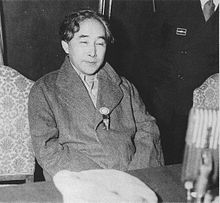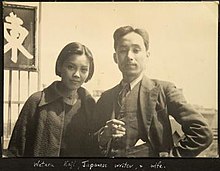Wataru Kaji
Wataru Kaji | |
|---|---|
鹿地 亘 | |
 Wataru Kaji in 1952 | |
| Born | Mitsugi Seguchi May 1, 1903 Misaki, Nishikunisaki District, Empire of Japan |
| Died | July 26, 1982 (aged 79) |
| Alma mater | Tokyo Imperial University |
| Political party | Japanese Communist Party |
| Spouse | Yuki Ikeda |
Wataru Kaji (鹿地 亘, Kaji Wataru, 1 May 1903 – 26/27 July 1982)[1][2] was the nom de guerre for Mitsugi Seguchi (瀬口 貢, Seguchi Mitsugi), a Japanese writer, literary critic, and political activist.[3]
Biography
[edit]Wataru Kaji was born in the village of Misaki in what was then Nishikunisaki District, Ōita (today part of Bungotakada) in 1903. He became involved with activism starting while at Tokyo Imperial University, and joined the Japanese Communist Party in 1932. In 1934, Kaji was charged with violating the Peace Preservation Law and threatening the Kokutai, being jailed for around a year and resulting in his flight to China in January 1936.[4] He arrived in Shanghai, where he married Yuki Ikeda.[5] While in China, Kaji met Lu Xun,[6][7] Hu Feng,[8] Xiao Hong,[9] Edgar Snow,[10], and Koji Ariyoshi.[11] Kaji had also met Communist Party member Max Granich who, following the outbreak of the Second-Sino Japanese war, advised that Kaji should focus on Japanese POWs, which he based on the news of the CCP’s capture of many Japanese POWs after the Battle of Pingxingguan.[12]
In Shanghai, Kaji was placed under suspicion for working with Japanese socialists by Chiang Kai-shek's Nationalist government,[13] fleeing following the start of the Second Sino-Japanese War to Hankou via Hong Kong, then to Chongqing.[4] There, Kaji worked for the Chinese in propaganda campaigns, and re-educated Japanese POWs.[5] During the war, in December 1939, Kaji founded the Japanese People's Anti-war Alliance,[14] which was disbanded the following year due to a breakdown in relations between the Kuomintang and Communist Party and a subsequent increase in suspicion of leftists by the Nationalists.
Contacts with U.S. intelligence
[edit]By 1942, he had begun occasionally working in association with the United States Office of War Information. In April 1945, the U.S. Office of Strategic Services (OSS) requested that the Chinese government release Kaji from his work there to allow him to work for the OSS in setting up a POW re-education camp Kunming, which was granted. Kaji, however, was unwilling to give up his operational independence in full. In response, the OSS said it would "make no guarantees" but "would not hinder" his larger work with his group, the League for the Establishment of a Democratic Japan, an offshoot of the Japanese People's Anti-war Alliance that sought "the ultimate liberation of Japanese society from authoritarian political oppression and ... industrial capitalist exploitation" so long as the work's sponsorship was not traceable back to the OSS. Negotiations and dialogue collapsed after Kaji objected to several points in the contract sent to him, including a demand for an oath of loyalty from him and his wife, and that the OSS reserved the right to terminate the agreement at any point.[4]
Kidnapping by U.S. intelligence
[edit]

On 25 November 1951, Kaji was kidnapped by the Z-Unit (a black operations under Lt. Col Jack Canon), in what is today the city of Fujisawa, Kanagawa, and was held for more than a year in several locations.[15] According to Kaji, he was subjected to intense interrogation and torture, and was accused of being a spy for the Soviet Union, which he denied. He was given a demand to become a double agent for the United States, which he refused. Kaji attempted suicide via consumption of household cleaner on 29 November. The attempt failed, and his captors administered medical aid to both assist his recovery from the attempt, and from a persistent case of tuberculosis. After a Japanese-American officer in the Unit leaked a few details about Kaji's detention to the Tokyo press in September 1952, the leaker, as well as another Japanese-American officer who developed sympathy for Kaji, attempted to secure his release, first on 24 November informing Kōzō Inomata, a member of the National Diet for the JSP, who then notified police. One of the officers also made a formal public statement about what he had seen, followed shortly thereafter by a press conference involving Inomata, another officer, and Kaji's immediate family. On 7 December 1952, Kaji was released. He alleged that his capture was due at least in part to his refusal to work with the OSS under their conditions at the end of World War II.[4]
U.S. sources at the time, including the Embassy of the United States in Tokyo, disputed this account, with a statement issued on 15 December saying Kaji admitted to being "an active Communist intelligence agent" after his capture, and that he had concocted the story of being kidnapped due to a possible threat against his life from his superiors. They also claimed that after the end of the Allied-occupation of Japan in late April 1952, Kaji was under U.S. protection at his own request, as anything else would have been a violation of Japan's sovereignty following the withdrawal of foreign troops. After another man (a former double agent for the U.S. Counterintelligence Corps (CIC) communicating with the Soviet Union until the end of the occupation) was arrested by Japanese police for sending radio signals to the Soviet Union on 10 December, he had claimed Kaji was a member of the same spy ring, which Kaji denied. The U.S. cited this event as further evidence for their claims. Ultimately, both the double agent and Kaji were charged with sending sensitive information to Moscow. The former was put on trial and convicted in March 1953, with Kaji's trial delayed due to ongoing health issues. Kaji was found guilty in 1961 and given a mild suspended sentence, but was acquitted on appeal in 1969 due to lack of evidence. Details later emerged that Kaji was under surveillance by the U.S. prior to the other man becoming a double agent for the CIC, meaning that intelligence from him could not have been evidence proving the U.S. claim. Additionally, U.S. response intended to assassinate the character of Kaji, painting him as a likely traitor due to his actions opposing the Japanese government during World War II, as well as shore up the incumbent pro-American government in Japan headed by Prime Minister Shigeru Yoshida, which may have been destabilized should the true facts of the case have become known. It was also revealed that the kidnapping occurred without formal authorization by CIC senior leaders, and that shortly after the event, the CIC realized that Kaji knew little that would help them with regard to the Soviet Union following vague suspicions about his ties.[4]
Legacy
[edit]The Chinese documentary series Today in the History of Anti-Japanese War dedicated an episode to Kaji.[16]
Wataru Kaji was featured in the International Friends During the Anti-Japanese War, an exhibition organized by the Beijing People's Association for Friendship with Foreign Countries. The show "features 160 pictures of 39 foreign friends who worked together with the Chinese people and made contributions to China's independence and freedom."[17]
See also
[edit]- Teru Hasegawa
- Japanese dissidence during the Shōwa period
- Japanese in the Chinese resistance to the Empire of Japan
- Japanese People's Anti-war Alliance
References
[edit]- ^ Library of Congress Name Authority File. Accessed 19 January 2014
- ^ "Political writer Kaji died at 79". The Miami News.
- ^ Derek Challis (2002). The Book of Iris: A Biography of Robin Hyde. Auckland University Press. p. 542.
- ^ a b c d e Esselstrom, Erik. “From Wartime Friend to Cold War Fiend: The Abduction of Kaji Wataru and U.S.-Japan Relations at Occupation’s End.” Journal of Cold War Studies 17, no. 3 (2015): 159–83. https://www.jstor.org/stable/26926210.
- ^ a b Roth, Andrew (1945). Dilemma in Japan. Little, Brown. pp. 234–243.
- ^ Koshiro, Yukiko (2013). Imperial Eclipse Japan's Strategic Thinking about Continental Asia before August 1945. Cornell University Press. p. 100. ISBN 9780801451805.
- ^ Empire of Texts in Motion Chinese, Korean, and Taiwanese Transculturations of Japanese Literature By Karen Laura Thornber Page 75
- ^ Literary Societies of Republican China edited by Michel Hockx and Kirk A. Denton Chapter 13 Page 458
- ^ "Seminar: Home Away From Home: Displacement and Cosmopolitanism in the Itinerary of Xiao Hong". University of Hong Kong.
- ^ From Vagabond to Journalist: Edgar Snow in Asia, 1928-1941 By Robert M. Farnsworth Page 326 -327
- ^ From Kona to Yenan: The Political Memoirs of Koji AriyoshiBy Koji Ariyoshi, Alice M. Beechert, Edward D. Beechert page 104-105
- ^ "Fighting Fascism with 'Verbal Bullets': Kaji Wataru and the Antifascist Struggle in Wartime East Asia". Brill.
- ^ Esselstrom, Erik (2009), Crossing Empire's Edge: Foreign Ministry Police and Japanese Expansionism in Northeast Asia, University of Hawai'i Press
{{citation}}: CS1 maint: location missing publisher (link) - ^ Empire of Texts in Motion: Chinese, Korean, and Taiwanese Transculturations", Karen Laura Thornber, Page 75
- ^ Yakuza: Japan's Criminal Underworld By David E. Kaplan, Alec Dubro Page 47
- ^ 抗战史上的今天 12月19日 鹿地亘对记者谈反战同盟 (in Chinese). 【抗战史上的今天】官方频道---纪念中国人民抗日战争暨世界反法西斯战争胜利70周年. 20 December 2015.
- ^ "Int'l friends photo exhibition unveiled in Beijing". This Is Beijing. 23 July 2015.
Further reading
[edit]- 井上 桂子 (2012). 中国で反戦平和活動をした日本人―鹿地亘の思想と生涯. 八千代出版.
- Records of the Office of Strategic Services (Record Group 226) 1940-1947, Entry 211, Boxes 1-45. Location: 250/64/32/1. CIA Accession: 85-0215R. at the National Archives and Records Administration.
- Pingchao Zhu (2015). Wartime Culture in Guilin, 1938–1944: A City at War. Lexington Books. pp. 175–180.
External links
[edit]- "중국과 함께 했던 외국적 항일투사(사적)7-가지 와타루". 국가공공추도망 (The National Memorial). 30 June 2015.
- "John Young Obituary". ObitsforLife.com.
- "Chinese Attack Japs Today Near Shanghai Limits". The Daily Times. 23 May 1938.
- "Japs, Despondent Over War, Reported Ending Lives". St. Petersburg Times.
- "Sino - Japanese friendship urged". Tribune. 7 May 1952.
